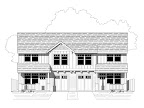The most important tool we use is AutoCAD LT. Without a digital drafting tool, we would be relegated to the physical tools of our forebears, that of a pencil and triangle. Though be not deceived. We have a great respect for those that still practice this dying art. AutoCAD can be a little spendy for the weekend warrior. The LT version is slowly approaching $1000 in price while the full version can be $4000 or more.
If you're just looking for a cheap tool that can still get the job done, we recommend A9CAD. This free tool has all of the functionality we need except for colortables. If we didn't have to print pretty pictures, we'd probably be using it.
DoubleCAD is another free product that has much more functionality, about as much as AutoCAD itself. The look and feel is a little different. DraftSight is another program we've found that almost perfectly replicates AutoCAD. It does tend to have a bit of a lag though.
Sometimes we'll play with 3-D imaging. Rather than pay the several thousand dollars to get the full version of AutoCAD, we've found the ever popular SketchUp from Google. Sketchup is clean, intuitive, and (like AutoCAD) has several different ways to do the same thing. We've found the basic version to be enough for our needs though we sometimes crunch the numbers to see if we could afford the $500 upgrade to Pro. Pro allows more functions including creating your own Dynamic Components. This means you don't have to create a 2x4, 2x6, 2x8, etc. You just create a joist and then before you insert, drop down menus allow you to choose width, height and length.
When you order a paper plan from us, we send the file to the printshop as pre-printed PDF sheets. They print the PDF sheets, bind them, and your plans are born. There are several ways to create a PDF. We've tried a few and the best one we've found is CutePDF. This application installs like a printer in your computer system. When you're ready to create a PDF from any program, go to print, and then select CutePDF as your printer. A myriad of paper sizes are available.
The images of our plans that are posted on the website are created through a two-step process. Unfortunately the quality of jpg and png that AutoCAD spits out are unacceptable. We've found that we get much better quality from a pdf. So we'll print the pdf (as mentioned above) and then open it up and export a jpg or png from the image.
Sometimes we'll further manipulate these images to get the size and contrast we want. For this we use Irfanview. Irfanview is another free program that does a bang-up job of manipulating image files. We have used it to crop images, manipulate size and resolution, glue images together and much more.
Our images are then uploaded to Picasa Web Albums by Google. The images on our website are referenced from Picasa as static images. You can link to your images so that they are clickable or not, have a border or not, and control the size that the viewer sees.
Our blog is hosted by Blogger, another Google company. The decision to use Blogger was merely one of convenience. Rather than have several different log-ins for several different web portals, we decided to keep everything with Google that we could.
To continue the Google theme (maybe we oughta buy stock?) we use
Our website was created with Google Page Creator. We were very pleased with the look we had built. A couple of years ago Google decided to close out Page Creator in favor of a program called Sites. Our website was converted to the new look and looked just awful. So we downloaded our coding from Page Creator and had it hosted privately. This has worked well but it means that when a change needs to be made that we have to manually log in and make the coding change ourselves. A small price to pay for having that much control.
Our website is now hosted on Google again. We switched to GoDaddy several years ago after reviewing their pricing structure. But personal decisions have led us away from there as well as their difficult to use page editor. Namecheap now has our URLs.
*edit: date of this post has been updated. Sorry for the repeat in your feeder!
*edit: some of our services have changed.






No comments:
Post a Comment